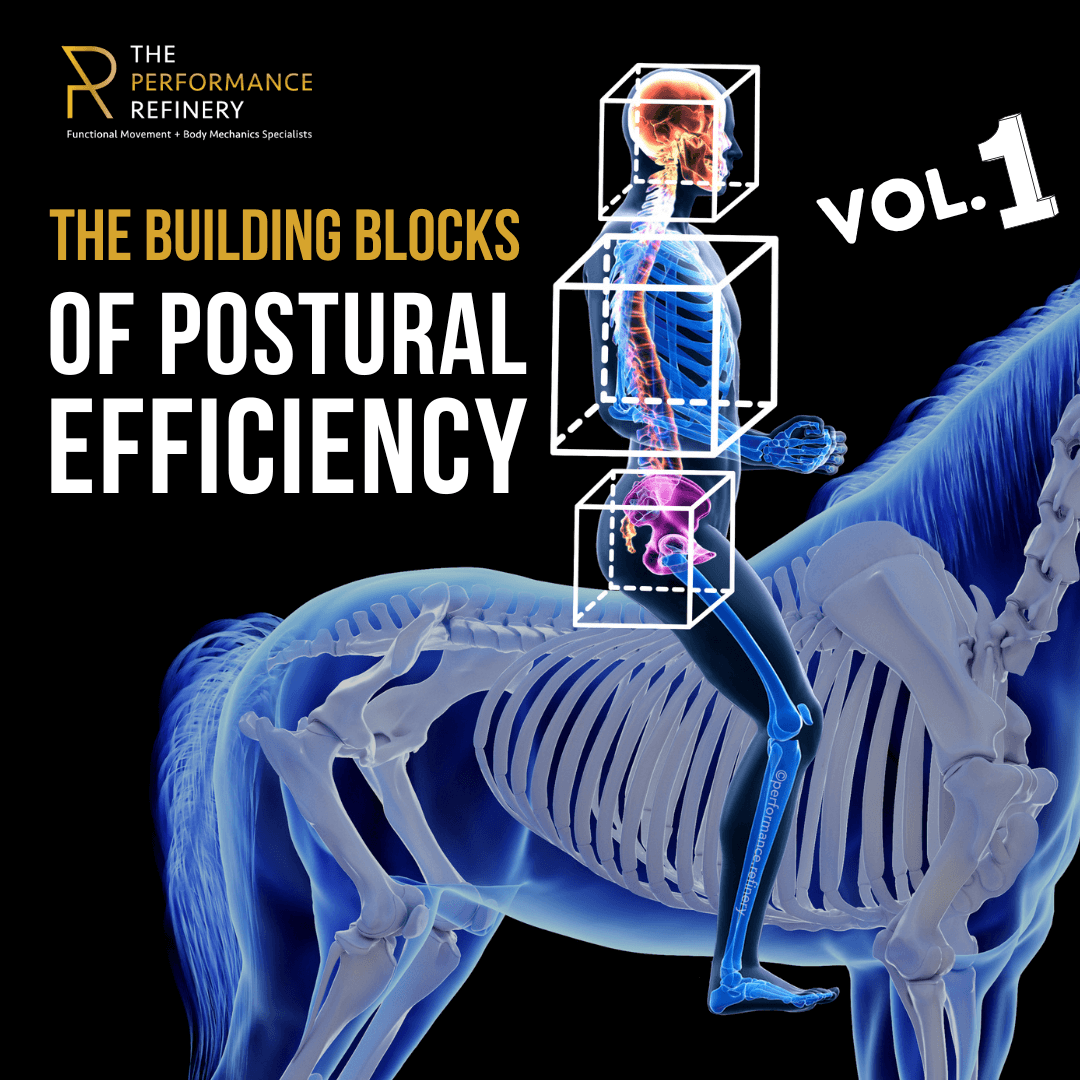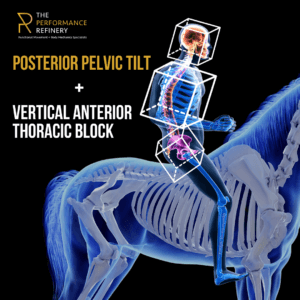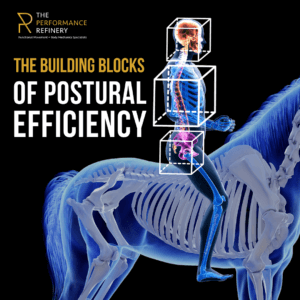Posture is defined as the way a person holds their body while sitting or standing. It addresses a state of neuromuscular and skeletal balance to best protect the structures of the body against injury or progressive deformity. An efficient structural alignment has been studied and proven to be most adequate when the distribution of loading forces remain in a Vertical Vertical stack. The thoracic block remains aligned over the pelvic block (Saliba Johnson et al., 2016). This postural positioning allows forces to be evenly distributed within the musculoskeletal system and assists in leading to pain free function of the neuro-musculo-skeletal system.
Conversations regarding posture are complex and can be slightly frustrating to the individual. In part, because as riders we know that our bodies influence our horses way of going, given their sensitivity to changes in our weight and seat/leg pressure, and the near impossibility of a rider to remain posturally “in tune” with the horse at every given moment. The very reason why we rely on over 100 billion neurons and our detailed vestibular system with its ‘righting reflex’ whilst riding. This Righting reflex (RR) enables the rider to correct the orientation of the body when it is taken out of its normal upright position, eg when it loses balance or is ‘adjusted’ in a direction due to the horses gait. There are 2 general categories of RR:
1. Bringing the head into upright or vertical orientation in space in relationship to gravity
2. Bringing the head, trunk and pelvis into mutual alignment with each other
Neither of these RR are mutually attainable if one of our subsequent postural building blocks is “off axis”.
From a very young age we are flooded throughout society with visual and vocal ideals that correct posture requires the rider to pull the shoulders back, sit/stand tall, suck in your belly and lift your head up. This alignment puts most riders into a Vertical/Posterior stack, with the forces transmitted between ribcage and pelvis off axis. Gravitational forces in this posture will cause extension in the lower lumbar spine with a forwards shear of the pelvis, decreasing the ability to sustain neutral balance without dysfunction occurring. I believe this to be one of the leading causes of insidious low back pain in the rider population!.
Dysfunctions in your postural building blocks are proven to cause imbalances in human mechanics and lead to postural dysfunctions. We should be ideally working towards a much more fluid concept of a Vertical/Vertical postural stack, inclusive of core first strategies with a feed forward mechanism, freedom of movement, natural balance, and coordination. Ideally, in the saddle we would like to establish sagittal balance with a neutral pelvis supported over our pelvic trampoline, the triangle between our pubic bone, pelvic floor and seat bones. An aligned spine with its natural curves, the ability to utilize our diaphragm and take a full relaxed breath, all with a sense of being supported by our skeletal structure without holding excessive tension. This should happen by the use of your individual RR under controlled instruction and cueing.
In equestrian sport we require dynamic sagittal balance. Combined we share a biomechanical language with sensitivity and communication to be able to express and co-ordinate ourselves in balanced movement together. Our job as riders is to absorb and consciously redirect all forces coming from gravity and the horse into our body. Depending on what our internal systems are telling us, we often want to redirect these forces in order to influence how the horse is moving. We might alter our weight distribution between seatbones (Pelvic Elevation/Depression) or slow down the tempo using our core strategies in a half halt to encourage a particular movement in our body and therefore ask the horse to change a particular movement in its body. This makes our postural alignment crucial due to the fact that the horse’s back has not evolved in design to carry and manage the load of a rider. It is our responsibility as riders to develop both the horse and ourselves to meet this challenge. Ideally we wish to be moving together in physical harmony. The rider must have the strength, mobility and skill to carry themselves whilst the horse has the ability to carry itself whilst also carrying the rider. Every rider has 3 pillars to their functional output: Mechanical Capacity, Neuromuscular Function and Motor Control. if one of these systems is hindered it will lead to dysfunction in the saddle. This is not a “One shoe fits all feet” type of system. The beauty in its complexity is the ability to delve into the systems of each individual rider and outline their individual dysfunction/s.
It is then riders responsibility to develop their ability to sit on the horse’s back in fluid unison. In order not to negatively affect movement throughout the horse’s whole body we must be-able to manage our own dynamic balance as we follow the horse’s back with our pelvis. In the dressage rider the pelvis is the base of support. Being able to maintain balance through developing feedforward mechanisms enables our muscles to manage forces transmitted from our horses movement to us. Adequate Mechanical capacity allows our pelvis to move appropriately with no restrictions.
Ok so what is sagittal balance?
This is when a vertical line falls through the center of mass allowing for horizontal gaze and the maintenance of the rider remaining upright without any external support and with minimal effort. All your internal feedforward systems are firing! As medical professionals we have a fantastic way of testing postural stability via a Vertical Compression test (VCT), as taught via the Postgraduate IPA program. This test allows the clinician to provide a vertical input until the patient has a postural give, grading and giving crucial feedback of external and internal systems. It is imperative to always do correct objective testing first as this gives the clinician necessary information prior to implementing any treatment/s for the rider.
So what happens when we are out of alignment!? A Postural give will happen when our systems are stressed (normally externally eg adjusting for our horse’s movement/s) resulting in a shear, buckling or rotation across a segment or segments in the spine and/or pelvis. This is termed a ‘dysfunctional state’
Becoming conscious of the feeling of the movement in our pelvis and body allows us to connect on a deeper level with the horse. It allows us to make tiny adjustments in our posture in order to communicate with our horses. Having an understanding of any of our personal imbalances is the first part in giving us the ability to make positive changes. The greater the sensitivity to the subtlety of our own body the greater vocabulary we have. One of my mentors often resonates “My Intention to notice creates my library of reference” – Vicky Saliba Johnson from the IPA. We can then be more sensitive and subtle with our communication with our horse/s. Horses are naturally much more sensitive than us, we have some work to do to catch up to their level!
Watch out for Vol 2 coming out later this week where we discuss with video analysis pelvic movement in the saddle and the implications of mechanical taping on pelvic patterns.
🎓 Written by licensed New Zealand Manual & Sports Physiotherapist & U.S Equestrian HSSM Provider
Britta Pedersen
Equestrian Physiotherapist
RNZPT, MNZPT, MPT (P1E USA), CKTP, ESNZ Gold Medal (Dressage)
Tags: Alignment, Physiotherapy, Rider Biomechanics, Equestrian, proper posture





